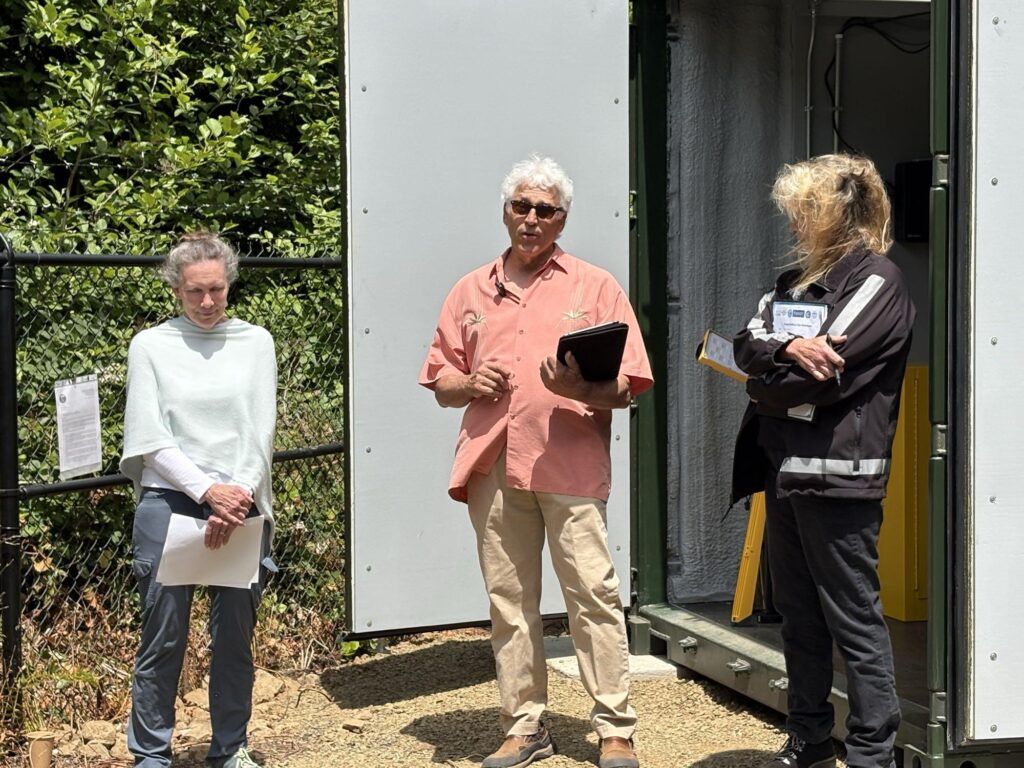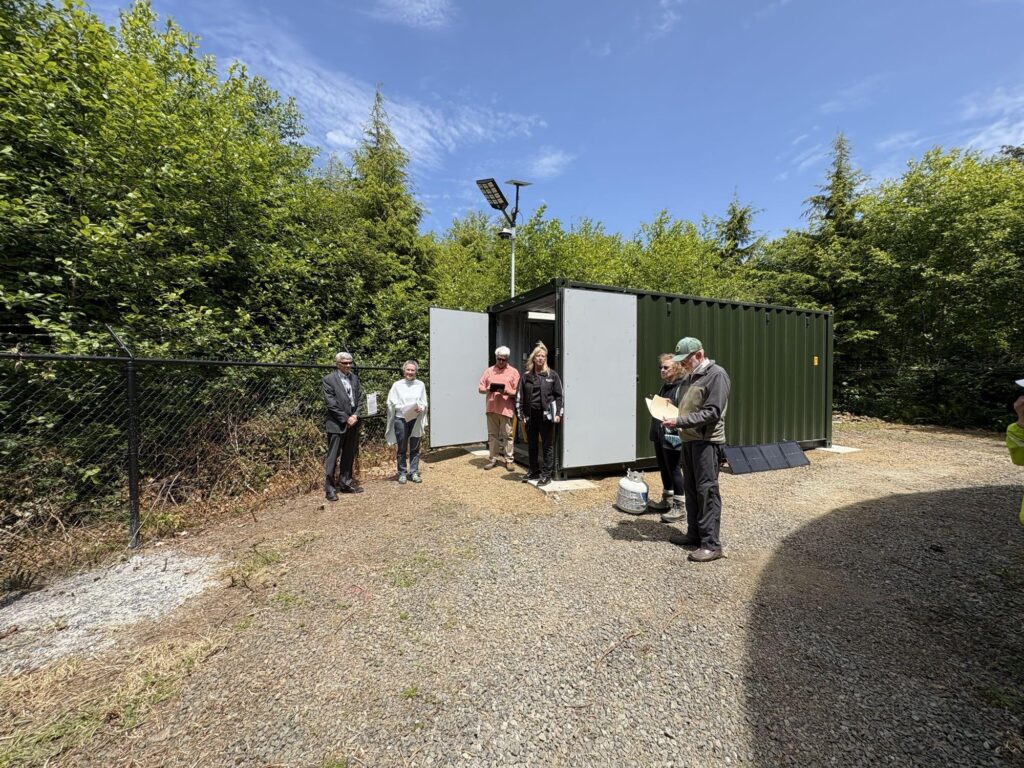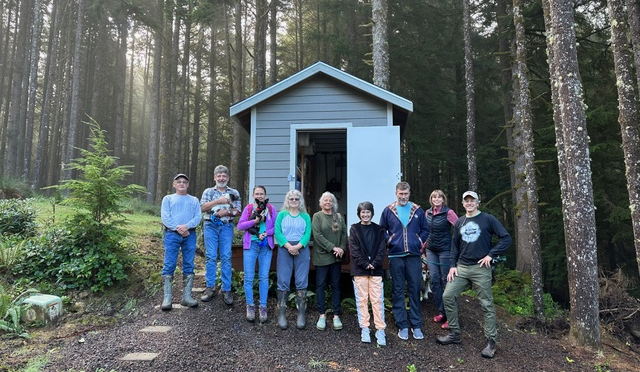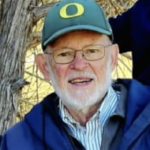Article on Resilience Hubs on North Coast
With Grant Award and CMCA Operating Funds- Conex Storage Box Installed



Cape Meares Community Association received large grant from Oregon Resiliency and Emergency Preparedness (OREM) for a fully equipped Conex Box.
Huge thanks to Miriam Fultz who was the lead for a grant writing team working with team members Kathy Burke, Pam Robenolt and Charles Ansorge.
After initially receiving a notice from the Oregon Resiliency and Emergency Preparedness (OREM) office in early April that a grant request would not be funded, the lead for Emergency Preparedness for Cape Meares, Kathy Burke, received a surprise call from the OREM informing her that one of the items in our grant request had been funded. The award was for $98,749 for a fully equipped Conex box ($38,150 for the box and $60,599 for the contents).
In June 2025 the Conex box and contents were received and installed in a secured fenced area at the Oceanside Water District -Cape Meares water treatment plant.
The box has an electrical connection for a heater, humidifier, and built-in lighting. The electronic gear includes the ability to communicate with all local GMRS devices, short-wave communication, HAM connection to the world, and StarLink for wi-fi. This is now a “hot spot” for the community if the internet is disrupted.
This electronic gear enables our community to create an Emergency Operations Command Center (EOCC) which includes a 30-day full power back-up system.
CMCA has an agreement with the Oceanside Water District to site the Conex box at the water treatment plant and our water reservoir. This site was chosen for the following reasons:
Location is one of the five designated Assembly Points by DOGAMI,
It is a secure fenced-in compound,
Site has 12 concrete piers installed that reach a depth of nearly 80 feet below the surface to provide stability to the property,
Potable water may be available from the reservoir following an earthquake and tsunami, and
Site is near a drop zone that drones or helicopters may be able to deliver emergency supplies safely.
In order to accept this award from OREM, CMCA in partnership with OWD obtained required permits, insurance, and electrical connections. The box becomes the property of CMCA two years from the time of delivery and installation.
Tip of the Month
Charles Ansorge, CMCA Emergency Preparedness Team
Preparing in advance is the key to ensuring the safety and resilience of your household and neighbors during emergencies.
Living in a beautiful costal community like Cape Meares comes with unique challenges, including the risks of tsunamis, earthquakes, fires, landslides, strong winds, and floods. The emergency tips below were previously shared, but a refresh following the recent wind event in our community that resulted in a power loss for many of up to 15 hours may be in order.Plan of Action: There should not be just one plan. We face multiple threats in our community. A December 25, 2024, windstorm in the area had sufficient strength to level a large tree and block the departure of residents who live on 5th St. north of Pacific. What was the plan for an emergency evacuation from the community for these residents?
Strengthen Your Home and Property: To mitigate damage from strong winds or earthquakes, secure heavy furniture, anchor appliances, move items indoor that might blow away and ensure your roof and windows are reinforced. We need to remain vigilant to tree trimming to avoid power outages due to strong winds blowing branches across wires. If your residence is surrounded by trees be sure to check the gutters for stoppage to avoid an overflow during rain events.
Stay Informed and Connected: If you have not already done so, sign up for local emergency alerts. In the last community newsletter Pam Robenolt shared information regarding acquiring an emergency radio in order to communicate with local neighborhood captains to learn more about the emergency of the moment. All captains are asked to switch on their radios after a power loss and assist with any community emergency that may need attention.
I’ve lived in Cape Meares for 12 years and during that period experienced a good many power outages. A large majority of the outages are temporary, a few hours to perhaps a day. Many of us have gas-powered generators that can be started up and are usually sufficient to keep a refrigerator and freezer running but can power little else. A new product is available that might be worth studying in greater detail. Pam Robenolt and Kathy Burke alerted me to this alternate power source. It’s worth a look. https://www.bioliteenergy.com/pages/backup
Also check out“Tsunami: Race Against Time.” on Hulu. A “two thumbs up” rating from me.
Pam Robenolt and Charles Ansorge,
Cape Meares Emergency Volunteer Corps
“There is no need to look further than the recent events with Hurricane Helene to see that communication during and after an emergency is vital for response and recovery. “
We cannot count on cell phones and email, especially in more rural areas. Allowing people to connect with family members, support systems and the community is crucial to identify who may need help, allocating resources, and for peace of mind.
The Cape Meares Block Captains use General Mobile Radio Service (GMRS) radios for emergency communication, when needed. These radios are commonly used for short distance, two-way voice communication. The radios have multiple channels that monitor information from the police, fire, forestry, weather, etc. as well as channels that allow for direct communication with others in fairly close proximity.
We currently have monthly check-ins on the 1st of the month at 5pm (on Ch. 20). In case of a power outage, we turn on our radios within 30 minutes and share any information that is known about the outage and expected restoration times. This can be helpful and comforting to those who lose cell coverage and WiFi during an outage. Our GMRS radios will also be used during the upcoming Great Oregon ShakeOut with reports made from our Assembly Points and then to our contact in Bay City to share our participation results in the practice event. We have more extensive protocols for internal communication during a natural disaster.
We encourage households in Cape Meares to have a GMRS radio so you can be informed of critical updates during an emergency or can communicate your situation. In the Manzanita/Nehalem Bay area there are approximately 300 residents who purchased these radios. Radios cost about $70 on Amazon. If you are interested in more information, you can email Pam Robenolt for information on the radios and basics on how to use them. She is happy to work with individuals to help you become more comfortable using the radio.
| Cape Meares GMRS Radio Training February 4, 2025, 4pm at Community Center Cape Meares has 8 neighborhoods. Each neighborhood has a Captain who has a GMRS radio. Other residents have the same radios and participate in a monthly radio check-in on the first day of every month from 5 to 5:30 pm. These radios and their operators are a vital intra-community communications link for post emergency networking. The Cape Meares Emergency Prep Group encourages all residents to purchase these radios and know how to use them. You can purchase a radio on Amazon for $65. It is BTECH GMRS-V2 5W 200 Fully Customizable Channels GMRS Two way radio. |  The training will be led by David Audet. Everyone is invited to attend and bring their GMRS radios. The training will be led by David Audet. Everyone is invited to attend and bring their GMRS radios. | ||||||||||
Mass Casualty Shelter Drill
On August 12, 2024 the Cape Meares Emergency Prep group hosted a Mass Casualty Shelter Drill for the community. Residents were asked to actively engage in the drill in order to gain experience on what might be expected following an earthquake and tsunami that forced them to flee to a safe assembly area above the inundation zone. More than 30 residents participated and self-selected to be a member of a task group that then tested a series of instructions created by the Emergency Prep group.
Following a significant earthquake and tsunami it is unlikely that those who are able to reach safety will be clear-minded regarding what they should do next. We do the planning now for various scenarios without having to deal with the serious stress associated with being a survivor. A major earthquake will not be just one event. During the first 24-48-72 hours post event there might be hundreds of aftershocks with some of them approaching or even exceeding the initial quake. There won’t be just one tsunami. Instead there will be multiple waves that come ashore and continue to inflict serious damage to property in the inundation zone area.
The severity of any event will determine how quickly it might be possible for the ground to stop shaking and the waves to cease coming ashore and for residents to start returning to their properties to assess damage. It is unlikely everyone who reached safety at an assembly area will quickly return to their homes. Tasks for the survivors will be required. Food needs to be prepared; there’s a shelter to erect; sanitation preparation needs attention; a plan for water procurement must be put in motion; and medical attention may be required for some survivors.
The shelter drill was very successful. Much was learned from the drill. Many of those residents who participated urged the scheduling of future drills in order for our community to build resilience so the day when the “Big One” arrives we will be prepared, survive, and live to see another day.
Tillamook People’s Utility District Grant 2024
Resilience is about how well we’re able to cope, adapt or “bounce back” when we experience hardship or trauma.
For more than a decade Cape Meares residents have been building resilience. Personal contributions and successful grant-seeking activities have enabled us to build and stock three emergency storage facilities. This spring a grant seeking team led by Miriam Fultz applied for several grants with success for one and awaiting results for two others. Funds from a successful Tillamook County Public Utilities (TPUD) Grant were used to acquire critical items that will strengthen our community resilience.
The major natural disaster we most fear is an earthquake, one serious enough to trigger a tsunami to cause at least 70% of the residents having to flee their homes. Because of multiple after-shocks following a major earthquake, remaining at a safe location may be necessary for approximately 72 hours before venturing back to our homes to assess damage and to access supplies.
Our successful TPUD grant 2024 focused on the shelter component. The two assembly points where shelters are planned are at 3rd St. and 8th St. At each location there will be a 12’ x 16’ tent that includes a cooking and heating stove.
EMERGENCY PREPAREDNESS
TIP OF THE MONTH January 2024
Charles Ansorge, CMCA Emergency
Preparedness Team
Hydration: Importance of access to drinkable water in an emergency
Wilderness guides often refer to the “Rule of 3,” which says that a person can live for three minutes without air, three days without water, and three weeks without food. This month’s emergency prep tip is about the second “rule.” Hydration.
If our community experiences an earthquake our first reaction should be to “drop, cover, and hold on” until the shaking stops. The second reaction should be to head to a safe location. But not long after the first two actions our thoughts should turn to finding shelter, food and drinkable water.
For nine months of the year a sufficient quantity of natural water is available around our community via streams, but it must first be treated so it is safe to drink. Various measures are available for water purification, but having bottled water stored in an accessible space is essential. It is wise to store at least a 72-hour supply of drinkable water per person.
There is another possible source of potable water that we might access. Our 200,000-gallon water reservoir supplies drinking water to our community. The Oceanside Water District is seeking grant funding for acquiring and installing expensive seismic shut-off valves ($30 K each) that will automatically cut the flow of water to the community when violent earth shaking occurs. Why? Because a violent earthquake is likely to rupture multiple pipes in the distribution system with multiple leaks that could quickly empty the tank. Preserving this valuable water resource is critical. So, we can’t count on our water reservoir supplying needed drinking water so every resident should have a plan for having a variety of potable drinking water sources.
Prepare Your Pets for an Emergency
Part-time or full-time residents of Cape Meares should make preparations for emergency events not only for themselves but also for their pet(s). Consideration should be given to having a Go-bag for your pet(s) that includes a three-day supply of food and water, first aid supplies, medications along with the pet’s medical record, vaccination history, and a current photo. Keep ID tags with current contact information on your animal’s collar at all times. Pet owners should understand their pet’s behavior in stressful situations and have a plan to calm or restrain them, if needed. Animals are likely to bolt, and you will likely be distracted by other matters so include a rope to tie your pet in the Go-bag. In times of crisis, pets may take cues from their owner’s behavior so remain as calm as possible to reduce their anxiety. Keep a small blanket or towel with the pet’s scent on it in the Go-bag so the animal has a familiar scent in a strange location. Lastly, pet owners should consider offering to help or take the lead on caring for pets that arrive in an assembly areas following a disaster.



